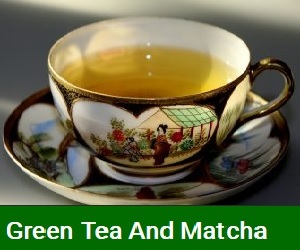
The tea ceremony is a very special event in Japanese culture. The host spends days going over every detail to make sure that the ceremony will be perfect. There are various styles of tea ceremonies and it is recognized that every human encounter is a singular occasion that will never recur again in exactly the same way, and so every aspect of the tea ceremony is savored. The ceremony takes place in a room called the chashitsu. This room is designed and designated only for this ceremony. The room is usually within a teahouse, and is located away from the residence in the garden.
The Guests' Arrival
When guests arrive (usually four), they are led into a waiting room (machiai) by the host's assistant (the hanto). The hanto offers the guests sayu (hot water that is used in making tea). While in the machiai, the guests choose one person to act as the main guest. The guests are then lead by the hanto into a garden that is sprinkled with water. This area is called roji or dew ground. No flowers grow here. It is in this garden that the guests are to remove the dust of the world. They sit on the koshikake machiai (waiting bench) and wait for the host (teishu).
Preparing for Guests
Before receiving guests, the teishu fills a stone basin (tsukubai) with fresh water and then purifies his hands and mouth. He proceeds through the middle gate (chumon) to receive his guests. The guests are welcomed only with a bow. No words are spoken. The teishu leads the assistant host, the main guest and then the guests, in that order, through the chumon. The chumon signifies the door between the harsh physical world and the spiritual world that is symbolized by tea. At the stone basin, the guests and host's assistant purify themselves and enter the teahouse through a sliding door that is just three feet high. To enter everyone has to bow, and this signifies that all are equal regardless of status or social position. The last person to enter puts the latch on the door.
Inside the Teahouse
There are no decorations in the teahouse except for an alcove called a tokonoma, in which a scroll painting (kakemono) is hung. This hanging is carefully chosen by the host and reveals the theme of the tea ceremony. In turn, each guest admires the scroll, the kettle (kama) and the hearth. Guests are seated according to their respective positions in the ceremony. Once the host seats himself, greetings are exchanged between the host and the main guest, and then the other guests.
The Tea Ceremony
In the tea ceremony, water represents yin. The fire in the hearth represents yang. A stoneware jar called the mizusashi holds fresh water and symbolizes purity and only the host touches it. The green tea called matcha is kept in a small ceramic container called a chaire that is covered in a fine silk pouch (shifuku) and is set in front of the mizusashi.
If tea is served during the day a gong sounds, or if it is evening a bell tolls five to seven times to summon the guests back to the teahouse. Everyone purifies their hands and mouths once again, and then re-enters the teahouse to admire the flowers, kettle and hearth before seating themselves.
The host enters carrying the tea bowl (chawan) that holds the tea whisk (chasen), the tea cloth (chakin) and the tea scoop (chashaku). The tea bowl represents the moon (yin) and is placed next to the water jar, which represents the sun (yang). The host goes to the preparation room, and returns with the waste water bowl (kensui), the bamboo water ladle (hishaku) and a green bamboo rest called a futaoki for the kettle lid.
The host purifies the tea container and tea scoop with a fine silk cloth (fukusa). He fills the tea bowl with hot water and rinses the whisk. He then empties the tea bowl and wipes it with a tea towel called a chakin. At this point the host lifts the tea scoop and tea container and places three scoops of tea per guest into the tea bowl. He ladles enough hot water from the kettle into the tea bowl and uses the whisk to make a thin paste. Additional water is added to the paste until it is the consistency of cream soup, returning any unused water to the kettle. The host passes the tea bowl to the main guest first who bows and accepts it. The main guest admires the bowl by raising and rotating it. He then drinks some of the tea, wipes the rim of the bowl, and passes it to the next guest who does the same thing.
When all the guests have tasted the tea, the bowl is returned to the host who rinses it, and cleans the tea scoop and tea container. The host offers the cleaned tea scoop and tea container to the guests for examination. Afterwards the group engages in conversation about the objects used in the tea ceremony and the presentation that took place.
,
The Japanese Tea Ceremony: Cha-No-Yu (Tuttle Classics)
"Translator and cultural historian A.L. Sadler takes the reader on a detailed and anecdotal tour of the tea ceremony, first published in 1933, giving descriptions of the many disciplines contained within the broader framework of Cha-no-yu, including art, architecture, gardening, and crafted objects. He relates the experiences of masters of the art over the centuries, and histories of the various schools and traditions of the art of tea. Black and white photos of tea bowls, teahouses, and gardens—and drawings of furniture and utensils, tearoom architecture, garden design, and floor and ground plans—reveal the exquisite artistry of the cult of tea.
The Book of Tea: Okakura Kakuzo
"Nearly a century ago in Boston, a small, esoteric book about tea was written with the intention of being read aloud in the salon of Isabella Gardner. ""There is a subtle charm in the taste of tea which makes it irresistible and capable of idealization,"" wrote its author Okakura Kakuzo, a Japanese philosopher and art curator later known as Tenshin, who had a genius for bridging Western and Eastern cultures. ""It has not the arrogance of wine, the self-consciousness of coffee, nor the simpering innocence of cocoa."" The Book of Tea introduced the West to the ""cult of tea"" and has been in print continuously ever since. This edition presents Okakura's delicious wisdom in a graceful, old-fashioned font on a spacious page, set off with atmospheric quadratone photographs of tea ceremony accoutrements. Liza Dalby, the first non-Japanese ever to have become a geisha, provides an introduction. Interwoven with a rich history of tea and its place in Japanese society is a poignant commentary on the abandonment of Eastern culture since the opening of Japan to the West—a loss Okakura passionately worked to recover—as well as essays on art, spirituality, and poetry.




